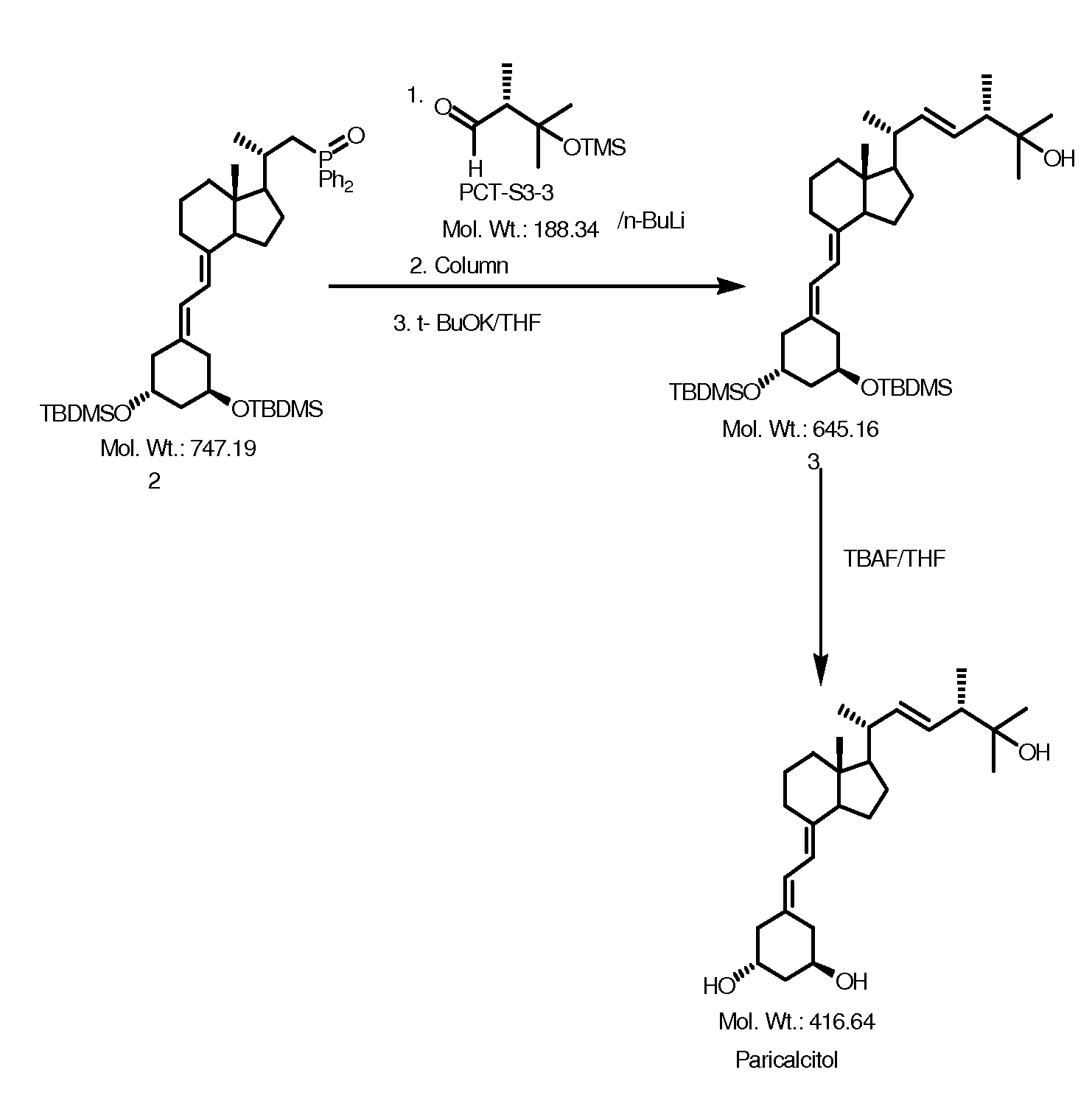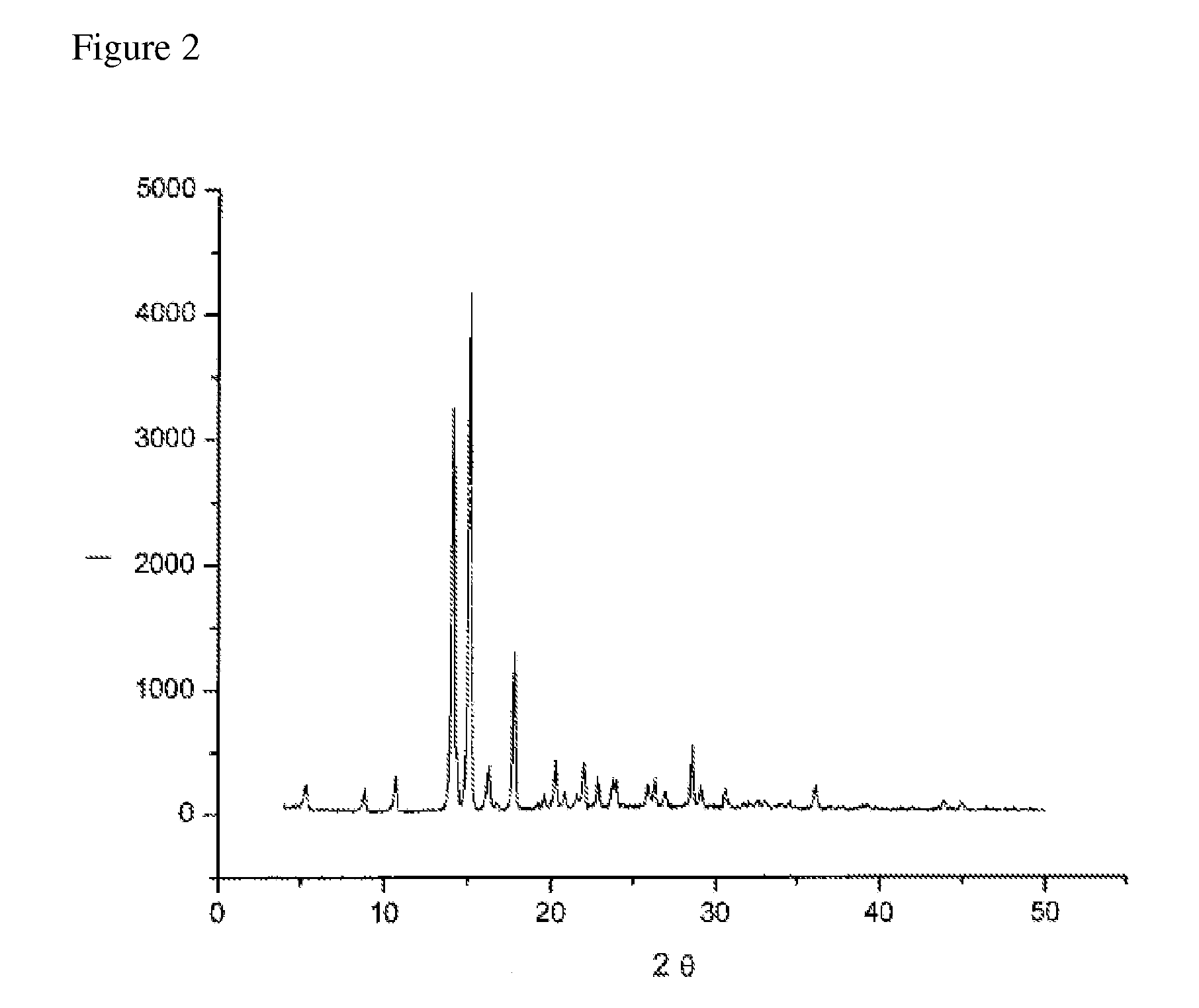Preparation of Paricalcitol
a technology of paricalcitol and paricalcitol, which is applied in the field can solve the problems of long time problem of purification of paricalcitol, unsatisfactory by-products, and inability to meet the requirements of the final product,
- Summary
- Abstract
- Description
- Claims
- Application Information
AI Technical Summary
Problems solved by technology
Method used
Image
Examples
example 1
Purification of Paricalcitol
[0063]Experimental data for displacement chromatography are as follows:
[0064]The Paricalcitol crude purity was around 97% and the total impurities were 3.0%.
[0065]The stationary phase was an octadecyl silica gel column 50×200 mm (reverse phase, XBridge™ Prep C18, 5 μm OBD™, Waters Inc.) with a particle size of 5 μm.
[0066]The mobile phase with a flow rate of 10 mL / min consisted of 55% acetonitrile in water.
[0067]The entering crude Paricalcitol (13.7 g) had a concentration of 50 mg / mL of methanol.
[0068]The capacity of the process was 100 mg of sample per hour.
[0069]The total yield of the obtained product was 88%. The product was separated into two fractions, if necessary, the other fraction being repeatedly purified.
[0070]The suitable fraction was concentrated to remove the organic solvent, after concentration to obtain Pure Paricalcitol (purity of 99.9%).
[0071]The Pure Paricalcitol was dried at 28° C. under vacuum (P˜2 mmHg) for 48 hours, to give 13.7 g cr...
example 2
[0072]The Paricalcitol crude purity was around 97% and the impurities were 3.0%.
[0073]Sample preparation: 1 g Crude Paricalcitol in 25 mL methanol or DMSO.
[0074]The stationary phase was an octadecyl silica gel column 19×100 mm (reverse phase, Sunfire™ Prep C18, 5 μm OBD™ Waters Inc.) with a particle size of 5 μm.
[0075]The mobile phase with a flow rate of 110 mL / min consisted of 55% acetonitrile in water. The entering crude Paricalcitol (1 g) had a concentration of 50 mg / mL of Methanol. The capacity of the process was 100 mg of sample per hour.
[0076]The total yield of the obtained product was 75%. The product was separated into two fractions, if necessary, the other fraction being repeatedly purified.
[0077]The suitable fraction was concentrated to remove the organic solvent, after concentration, pure Paricalcitol (purity of 99.5%) was obtained.
example 3
[0078]The Paricalcitol crude purity was around 97% and the impurities were 3.0%.
[0079]Sample preparation: 1 g Crude Paricalcitol in 25 mL methanol.
[0080]The stationary phase was an octadecyl silica gel column 19×100 mm (reverse phase, Atlantis™ Prep C18, 5 μm OBD™ Waters Inc.) with a particle size of 5 μm.
[0081]The mobile phase with a flow rate of 110 mL / min consisted of 55% acetonitrile in water. The entering crude Paricalcitol (1 g) had a concentration of 50 mg / mL of Methanol. The capacity of the process was 50 mg of sample per hour.
[0082]The total yield of the obtained product was 80%. The product was separated into 2 fractions with two fraction, if necessary, the other fraction being repeatedly purified.
[0083]The suitable fraction was concentration to remove the organic solvent, after concentration, pure Paricalcitol (purity of 99.70%) was obtained.
PUM
 Login to View More
Login to View More Abstract
Description
Claims
Application Information
 Login to View More
Login to View More - R&D
- Intellectual Property
- Life Sciences
- Materials
- Tech Scout
- Unparalleled Data Quality
- Higher Quality Content
- 60% Fewer Hallucinations
Browse by: Latest US Patents, China's latest patents, Technical Efficacy Thesaurus, Application Domain, Technology Topic, Popular Technical Reports.
© 2025 PatSnap. All rights reserved.Legal|Privacy policy|Modern Slavery Act Transparency Statement|Sitemap|About US| Contact US: help@patsnap.com



